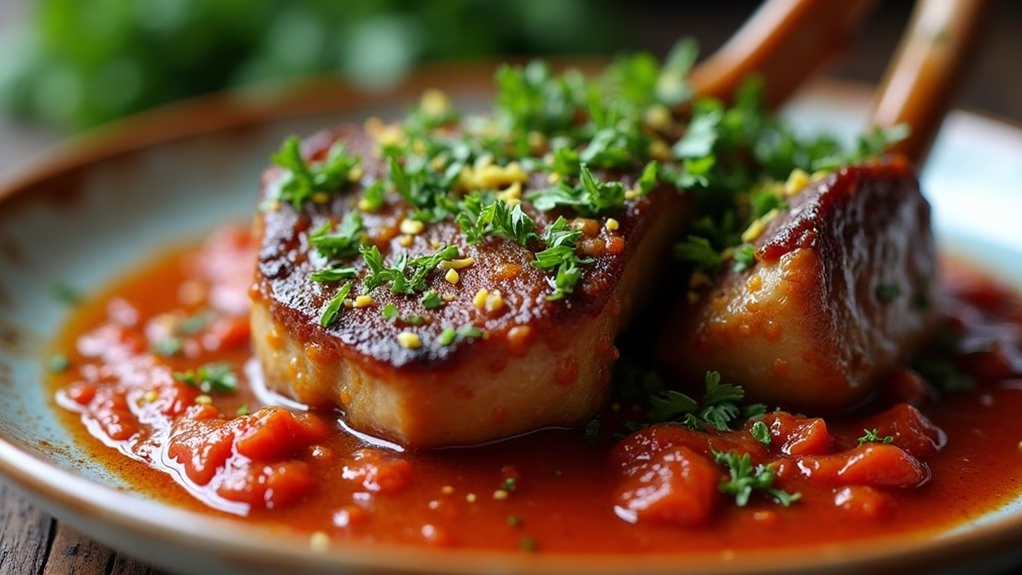The holiday season is the perfect time to whip up a Christmas dinner that keeps everyone talking. There’s something magical about a classic prime rib roast or the sophisticated touch of beef Wellington on the table. With 15 mouth-watering beef recipes to choose from, each dish brings its own special flair. Let your culinary skills shine and make this season’s feast truly memorable. Ready to impress your guests with flavors they’ll love?
Classic Prime Rib Roast
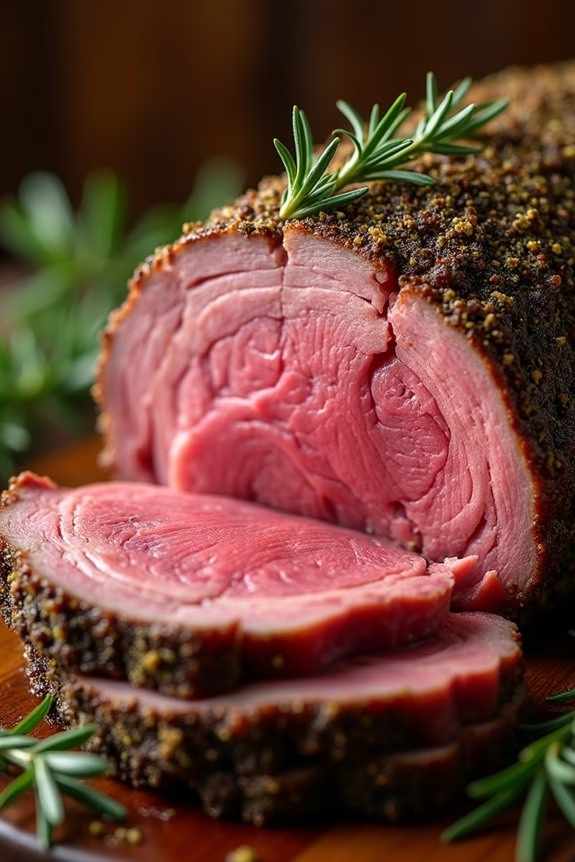
A classic prime rib roast is the epitome of a luxurious Christmas dinner, providing an exquisite centerpiece that promises to impress your guests. This cut of beef is known for its rich marbling and tenderness, making it perfect for a festive occasion. The key to a perfect prime rib roast lies in selecting a high-quality piece of meat and cooking it to perfection to guarantee a juicy, flavorful dish that will have everyone asking for seconds.
For this recipe, we’ll be focusing on a traditional preparation that highlights the natural flavors of the beef. The prime rib will be seasoned with a simple yet effective combination of herbs and spices, creating a savory crust that complements the tender meat. The cooking process involves a reverse-sear method, allowing the roast to cook evenly and develop a beautiful crust. This recipe serves 4-6 people, making it ideal for an intimate holiday gathering.
Ingredients:
- 1 (4-5 pound) bone-in prime rib roast
- 4 cloves garlic, minced
- 2 tablespoons olive oil
- 2 tablespoons kosher salt
- 1 tablespoon freshly ground black pepper
- 1 tablespoon fresh rosemary, chopped
- 1 tablespoon fresh thyme, chopped
Cooking Instructions:
- Preparation: Begin by removing the prime rib roast from the refrigerator at least 2 hours prior to cooking. Allowing the meat to reach room temperature guarantees even cooking throughout.
- Seasoning: In a small bowl, combine the minced garlic, olive oil, kosher salt, black pepper, rosemary, and thyme. Mix well to form a paste. Rub this paste generously over the entire surface of the prime rib, making sure all sides are evenly coated. This step infuses the meat with flavor and helps create a delicious crust.
- Preheat the Oven: Preheat your oven to 250°F (120°C). This low temperature allows the roast to cook slowly and evenly, preserving its juiciness.
- Roasting: Place the seasoned prime rib on a rack in a roasting pan, bone side down. Insert a meat thermometer into the thickest part of the roast without touching the bone. Roast in the preheated oven until the internal temperature reaches 120°F (49°C) for medium-rare, or until your desired level of doneness is achieved. This should take approximately 3-4 hours.
- Resting: Once the desired temperature is reached, remove the roast from the oven and tent it loosely with aluminum foil. Allow it to rest for at least 20-30 minutes. Resting is essential as it allows the juices to redistribute, resulting in a moist and tender roast.
- Final Searing: Increase the oven temperature to 500°F (260°C). Return the rested roast to the oven for an additional 10-15 minutes to develop a crispy, browned crust. Keep a close eye on it to prevent over-browning.
- Carving: Remove the roast from the oven and let it rest briefly before carving. Slice the prime rib into thick slices and serve immediately.
Extra Tips:
When selecting your prime rib, look for a roast with good marbling, as this contributes to the flavor and tenderness of the meat. If you have time, consider dry-aging the roast in your refrigerator for up to three days before cooking to enhance its flavor further.
Beef Wellington With Mushroom Duxelles

Beef Wellington is a classic dish that’s both elegant and indulgent, perfect for a Christmas dinner centerpiece. This delightful dish features a tender beef fillet coated with mushroom duxelles, wrapped in prosciutto and puff pastry, then baked to golden perfection. The result is a harmonious blend of flavors and textures, with the savory richness of the beef and mushrooms balanced by the buttery, flaky pastry.
Mushroom duxelles—a finely chopped mixture of mushrooms, shallots, and herbs—adds a depth of flavor that elevates the dish to new heights. While it may seem complex, preparing Beef Wellington is a rewarding experience that will impress your guests. The key to success is in the preparation and careful assembly of each component, guaranteeing that the beef remains juicy and the pastry crisp and golden. Here’s a recipe for serving 4-6 people.
Ingredients:
- 2 pounds beef tenderloin fillet, trimmed
- Salt and freshly ground black pepper
- 2 tablespoons olive oil
- 1 pound mushrooms (such as cremini or button), finely chopped
- 2 shallots, finely chopped
- 2 garlic cloves, minced
- 2 tablespoons unsalted butter
- 2 tablespoons chopped fresh thyme
- 1/4 cup dry white wine
- 6 slices prosciutto
- 2 tablespoons Dijon mustard
- 1 package (14 ounces) puff pastry, thawed
- 1 egg, beaten
- All-purpose flour, for dusting
Cooking Instructions:
- Prepare the Beef: Season the beef fillet generously with salt and pepper. In a large skillet, heat the olive oil over high heat. Sear the beef on all sides until browned, about 2-3 minutes per side. Remove from the skillet and let it cool. Once cooled, brush the fillet with Dijon mustard.
- Make the Mushroom Duxelles: In the same skillet, melt the butter over medium heat. Add the shallots and garlic, sautéing until translucent. Stir in the mushrooms and thyme, cooking until the moisture has evaporated and the mixture is dry. Pour in the white wine, cooking until it’s completely absorbed. Season with salt and pepper. Allow the duxelles to cool.
- Assemble the Wellington: Lay out a large piece of plastic wrap. Place the prosciutto slices on the wrap, slightly overlapping to form a rectangle. Spread the mushroom duxelles evenly over the prosciutto. Place the beef fillet on top, then carefully roll it up, using the plastic wrap to form a tight log. Chill in the refrigerator for 15 minutes.
- Wrap in Puff Pastry: Preheat the oven to 400°F (200°C). On a floured surface, roll out the puff pastry into a rectangle. Remove the beef from the plastic wrap and place it in the center of the pastry. Fold the pastry edges over the beef, trimming any excess. Seal the seams by pressing with your fingers, then brush the pastry with the beaten egg.
- Bake the Wellington: Place the wrapped fillet seam-side down on a baking sheet lined with parchment paper. Brush with more egg wash for a golden finish. With a sharp knife, score the top of the pastry in a decorative pattern, taking care not to cut through. Bake for 25-30 minutes, or until the pastry is golden brown and the beef reaches an internal temperature of 125°F (51°C) for medium-rare. Let it rest for 10 minutes before slicing.
Extra Tips: For the best results, confirm that the beef fillet is at room temperature before searing to ensure even cooking. Chilling the wrapped fillet before baking helps the pastry maintain its shape. Use a meat thermometer to check the internal temperature of the beef to avoid overcooking. If desired, serve with a rich red wine reduction or a creamy mushroom sauce to complement the flavors of the dish.
Red Wine-Braised Short Ribs
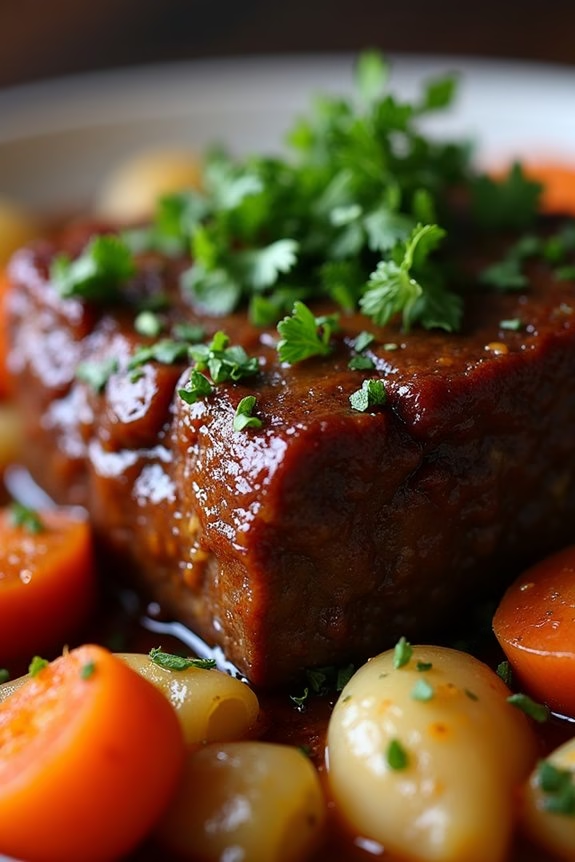
Red Wine-Braised Short Ribs are a decadent, comforting dish perfect for a Christmas dinner that brings warmth and flavor to the table. This recipe combines the richness of beef short ribs with the deep, complex flavors of red wine, herbs, and vegetables, resulting in tender, fall-off-the-bone meat that will impress your guests.
The slow-cooking process allows the flavors to meld beautifully, creating a dish that’s rich in taste and aroma. Ideal for serving 4-6 people, this dish is perfect for a festive gathering. Red Wine-Braised Short Ribs can be prepared in advance, allowing you to spend more time with your guests on the day of your holiday celebration.
Serve these succulent ribs with creamy mashed potatoes or a crusty bread to soak up the delicious sauce, and you’ll have a show-stopping centerpiece for your Christmas dinner table.
Ingredients (Serves 4-6):
- 4-5 pounds beef short ribs
- Salt and freshly ground black pepper
- 2 tablespoons olive oil
- 1 large onion, chopped
- 2 carrots, peeled and chopped
- 2 celery stalks, chopped
- 4 cloves garlic, minced
- 2 tablespoons tomato paste
- 2 cups red wine (preferably a dry variety like Cabernet Sauvignon)
- 3 cups beef broth
- 2 sprigs fresh thyme
- 2 sprigs fresh rosemary
- 2 bay leaves
- 2 tablespoons all-purpose flour (optional, for thickening)
- Fresh parsley, chopped (for garnish)
Instructions:
1. Prepare the Ribs:
Season the short ribs generously with salt and freshly ground black pepper. Make sure to cover all sides to enhance the flavor during the cooking process.
2. Brown the Ribs:
Heat the olive oil in a large, heavy-bottomed Dutch oven over medium-high heat. When the oil is hot but not smoking, add the short ribs in a single layer. Brown them on all sides, about 3-4 minutes per side. Do this in batches if necessary to avoid overcrowding the pot. Once browned, remove the ribs and set them aside.
3. Sauté the Vegetables:
In the same pot, add the chopped onion, carrots, and celery. Sauté for about 5-7 minutes, stirring occasionally, until the vegetables are softened and begin to brown. Add the minced garlic and cook for another minute until fragrant.
4. Add Tomato Paste and Wine:
Stir in the tomato paste, coating the vegetables. Cook for another 2 minutes. Pour in the red wine, scraping up any browned bits from the bottom of the pot. Bring to a simmer and let it reduce by half, about 10 minutes.
5. Combine Ingredients:
Return the browned short ribs to the pot. Add the beef broth, ensuring the ribs are mostly submerged. Add the thyme, rosemary, and bay leaves. Bring the mixture to a gentle simmer.
6. Braise the Ribs:
Cover the pot with a lid and transfer it to a preheated oven at 325°F (160°C). Braise for about 2.5 to 3 hours, or until the short ribs are fork-tender and the meat easily pulls away from the bone.
7. Thicken the Sauce (Optional):
If you prefer a thicker sauce, remove the ribs and vegetables from the pot and set aside. Place the pot on the stovetop over medium heat. In a small bowl, mix 2 tablespoons of flour with 2 tablespoons of water to form a slurry. Whisk the slurry into the sauce and cook for a few minutes until thickened.
8. Serve:
Return the ribs and vegetables to the pot, stirring to coat them in the sauce. Serve hot, garnished with freshly chopped parsley.
Extra Tips:
For a deeper flavor, consider marinating the short ribs in the red wine, herbs, and some garlic overnight before cooking. This will infuse the meat with even more flavor.
If you make the dish a day ahead, you can refrigerate it and remove the solidified fat from the surface before reheating, resulting in a leaner sauce. Additionally, use a wine you enjoy drinking, as the flavor of the wine will be prominent in the final dish.
Herb-Crusted Beef Tenderloin
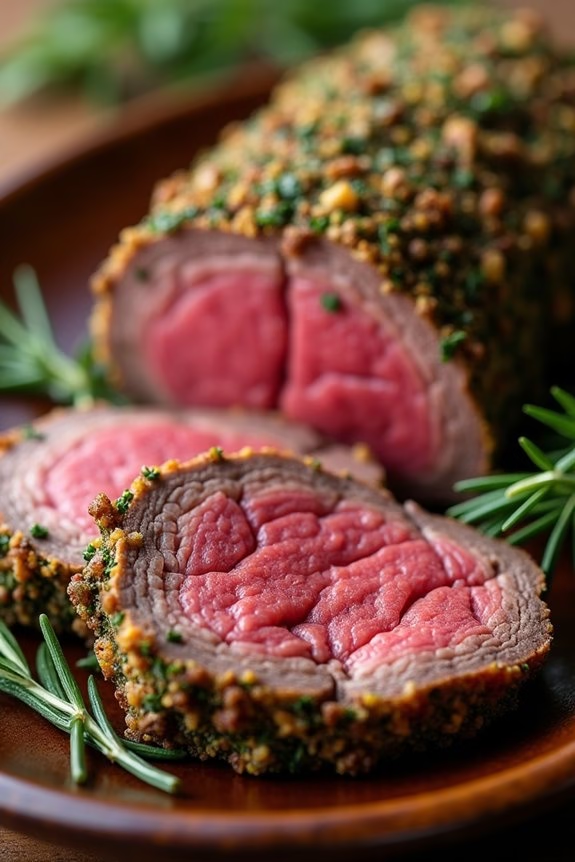
Herb-Crusted Beef Tenderloin is a sumptuous and elegant centerpiece for your Christmas dinner. This dish is perfect for those who desire a classic yet sophisticated meal that will impress family and friends. The beef tenderloin is renowned for its tenderness and flavor, making it an ideal choice for a holiday feast.
Coated in a delectable herb crust, this dish combines the rich taste of beef with aromatic herbs, resulting in a mouthwatering experience that will leave a lasting impression. The herb crust adds a fragrant and savory layer to the tenderloin, enhancing its natural flavors while providing a delightful contrast in texture.
This recipe is designed to serve 4-6 people, guaranteeing everyone at your table can savor the exquisite taste of this premium cut of meat. Whether you’re hosting a formal dinner or a cozy gathering, Herb-Crusted Beef Tenderloin will elevate your Christmas celebration to new culinary heights.
Ingredients (Serves 4-6):
- 1 (3-4 pound) beef tenderloin, trimmed
- 2 tablespoons olive oil
- 3 tablespoons Dijon mustard
- 2 cloves garlic, minced
- 1 tablespoon fresh rosemary, chopped
- 1 tablespoon fresh thyme, chopped
- 1 tablespoon fresh parsley, chopped
- 1 teaspoon salt
- 1 teaspoon black pepper
- 1 tablespoon vegetable oil
Cooking Instructions:
- Preparation: Preheat your oven to 425°F (220°C). Place the beef tenderloin on a clean surface and pat it dry with paper towels to remove any excess moisture. This will help the seasoning adhere better to the meat.
- Seasoning the Beef: Rub the tenderloin all over with olive oil. In a small bowl, mix together the Dijon mustard, minced garlic, rosemary, thyme, parsley, salt, and black pepper. Coat the beef evenly with the mustard and herb mixture, pressing gently to ascertain it sticks.
- Searing the Tenderloin: Heat a tablespoon of vegetable oil in a large oven-safe skillet over medium-high heat. Once the oil is hot, sear the beef tenderloin on all sides until it’s browned, about 3-4 minutes per side. This step locks in the juices and flavors, creating a delicious crust.
- Roasting: Transfer the skillet with the seared tenderloin to the preheated oven. Roast the beef until it reaches the desired level of doneness: about 20-25 minutes for medium-rare or until a meat thermometer inserted into the thickest part reads 130°F (54°C).
- Resting: Once cooked, remove the tenderloin from the oven and transfer it to a cutting board. Tent it loosely with aluminum foil and let it rest for 10-15 minutes before slicing. Resting allows the juices to redistribute, making the meat more tender and flavorful.
- Serving: Slice the rested tenderloin into thick medallions and arrange them on a serving platter. Garnish with additional fresh herbs if desired, and serve immediately.
Extra Tips: To guarantee even cooking, it’s important to let the tenderloin come to room temperature before searing. This can take about 30-45 minutes.
Additionally, when slicing the beef, use a sharp carving knife to achieve clean cuts without tearing the meat. If you prefer your beef cooked to a different level of doneness, adjust the roasting time accordingly, but always use a meat thermometer to ensure accuracy.
For an enhanced flavor profile, consider adding a splash of red wine to the pan drippings to create a simple, yet delicious sauce to accompany the beef.
Moroccan-Spiced Beef Tagine

Moroccan-Spiced Beef Tagine is a delightful, aromatic dish that brings the rich and exotic flavors of North Africa to your Christmas dinner table. This dish combines tender pieces of beef with a blend of warm spices, such as cinnamon, cumin, and coriander, which are slowly simmered to perfection in a traditional tagine pot or a Dutch oven. The result is a mouth-watering, savory meal that’s both comforting and full of depth, making it an excellent choice for a festive holiday gathering.
The beauty of a Moroccan-Spiced Beef Tagine lies in its ability to blend sweet and savory elements seamlessly. Dried fruits like apricots or raisins add a hint of sweetness, while preserved lemons and olives contribute a tangy, briny flavor. These ingredients, along with the slow-cooked beef, create a harmony of tastes and textures that are sure to impress your guests.
Serve this dish alongside couscous or crusty bread to soak up the luscious sauce, and you’ll have a memorable Christmas dinner everyone will love.
Ingredients for Serving 4-6 People
- 2 lbs beef chuck, cut into 1 1/2-inch cubes
- 2 tablespoons olive oil
- 1 large onion, finely chopped
- 4 cloves garlic, minced
- 1 teaspoon ground cinnamon
- 1 teaspoon ground cumin
- 1 teaspoon ground coriander
- 1 teaspoon paprika
- 1/2 teaspoon cayenne pepper (optional, for heat)
- 1/2 teaspoon ground ginger
- 1/2 teaspoon turmeric
- 1 (14 oz) can of diced tomatoes
- 2 cups beef broth
- 1/2 cup dried apricots, halved
- 1/2 cup green olives, pitted
- 1 preserved lemon, quartered
- Salt and pepper, to taste
- Fresh cilantro, chopped (for garnish)
- Cooked couscous or crusty bread, for serving
Cooking Instructions
- Prepare the Beef: Begin by patting the beef cubes dry with paper towels and season with salt and pepper. This helps to guarantee a good sear on the beef.
- Brown the Beef: Heat the olive oil in a tagine pot or Dutch oven over medium-high heat. Add the beef cubes in batches, browning all sides. Remove the beef and set aside.
- Sauté the Aromatics: In the same pot, reduce the heat to medium and add the chopped onion. Sauté until translucent, about 5 minutes. Add the minced garlic and cook for another minute until fragrant.
- Add the Spices: Stir in the cinnamon, cumin, coriander, paprika, cayenne pepper, ginger, and turmeric. Cook the spices for 1-2 minutes, allowing them to release their flavors without burning.
- Combine Ingredients: Return the browned beef to the pot. Add the diced tomatoes, beef broth, dried apricots, olives, and preserved lemon. Stir to combine and bring to a gentle simmer.
- Simmer the Tagine: Cover the pot and reduce the heat to low. Let the tagine simmer gently for 1.5 to 2 hours, or until the beef is tender and the flavors have melded beautifully. Stir occasionally and check for seasoning, adding more salt and pepper if needed.
- Finish and Serve: Once the beef is tender, remove from heat and sprinkle with fresh cilantro. Serve the tagine hot over a bed of couscous or with crusty bread on the side.
Extra Tips
For best results, use a tagine pot if you have one, as it’s designed for slow-cooking and will enhance the dish’s flavor. If not, a Dutch oven works perfectly well.
Make sure to adjust the seasoning according to your taste, especially the heat from the cayenne pepper. Preserved lemons add a unique flavor, but if unavailable, the zest of one fresh lemon can be used as a substitute.
Finally, the tagine can be prepared a day in advance, as the flavors deepen with time, offering an even richer taste when reheated.
Slow-Cooked Beef Bourguignon
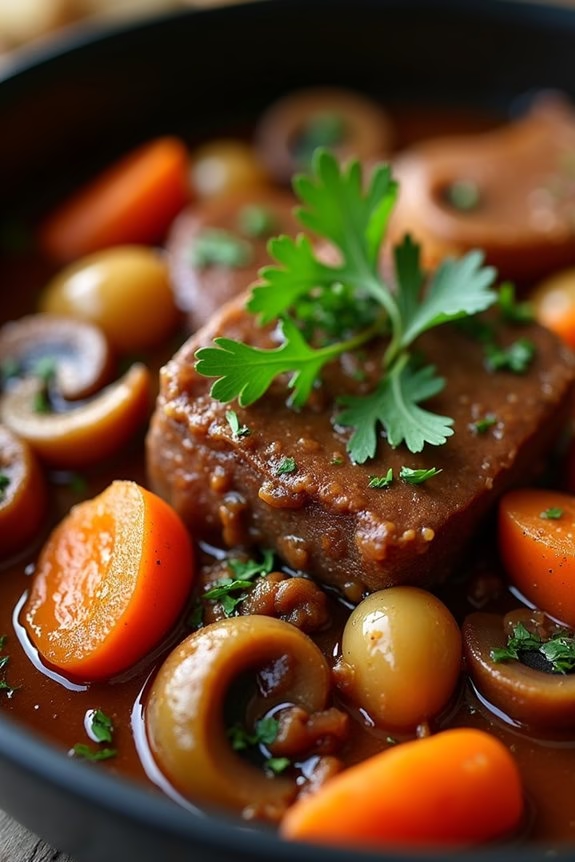
Beef Bourguignon is a classic French dish that’s perfect for a festive Christmas dinner. This slow-cooked version allows the rich flavors to develop over time, resulting in tender beef and a deeply flavored sauce. The dish combines beef with red wine, aromatic vegetables, and herbs, creating a comforting and elegant meal that’s sure to impress your guests.
The slow-cooking process not only enhances the flavors but also makes the beef incredibly tender, making it a perfect centerpiece for your holiday table.
This recipe is designed to serve 4-6 people, making it ideal for a small gathering or family dinner. While it requires a bit of preparation, the actual cooking process is quite hands-off, allowing you to focus on enjoying the holiday festivities. Pair it with a crusty baguette or creamy mashed potatoes to soak up the delicious sauce, and you’ll have a truly memorable Christmas dinner.
Ingredients for 4-6 servings:
- 2 pounds beef chuck, cut into 2-inch cubes
- Salt and pepper, to taste
- 2 tablespoons olive oil
- 4 slices bacon, chopped
- 1 large onion, chopped
- 2 cloves garlic, minced
- 2 tablespoons all-purpose flour
- 2 cups red wine (preferably Burgundy or Pinot Noir)
- 2 cups beef stock
- 1 tablespoon tomato paste
- 1 bouquet garni (a bundle of herbs, typically thyme, bay leaf, and parsley)
- 1 pound carrots, peeled and sliced
- 1/2 pound pearl onions, peeled
- 1/2 pound mushrooms, quartered
- Chopped fresh parsley, for garnish
Instructions:
- Prepare the Beef: Season the beef cubes with salt and pepper. In a large Dutch oven or heavy pot, heat olive oil over medium-high heat. Add the beef in batches, browning on all sides, about 4-5 minutes per batch. Remove the beef and set it aside.
- Cook the Bacon: In the same pot, add the chopped bacon and cook until crispy. Remove the bacon with a slotted spoon and set it aside with the beef.
- Sauté the Aromatics: Lower the heat to medium and add the chopped onion to the pot. Sauté until translucent, about 5 minutes. Add the garlic and cook for another minute.
- Thicken the Sauce: Sprinkle the flour over the onion and garlic, stirring to coat the vegetables. Cook for about 2 minutes, ensuring the flour is well incorporated.
- Deglaze and Simmer: Slowly pour in the red wine, scraping up any browned bits from the bottom of the pot. Bring to a simmer and let it reduce slightly, about 5 minutes.
- Combine Ingredients: Return the beef and bacon to the pot. Add the beef stock, tomato paste, and bouquet garni. Stir well to combine all ingredients.
- Slow Cook: Cover the pot and transfer it to a preheated oven at 325°F (160°C). Allow it to cook for 2 hours.
- Add Vegetables: After 2 hours, add the carrots, pearl onions, and mushrooms. Stir to combine and return to the oven for an additional hour, or until the beef is tender and the vegetables are cooked through.
- Finish and Serve: Remove the pot from the oven, discard the bouquet garni, and adjust seasoning with salt and pepper if needed. Garnish with chopped fresh parsley before serving.
Extra Tips:
For the best results, use a good quality red wine that you’d enjoy drinking, as it greatly impacts the flavor of the dish. If you don’t have a bouquet garni, you can use dried herbs, but fresh ones will yield a more robust flavor.
The dish can be made a day ahead, which allows the flavors to meld even more. Just reheat gently before serving. Pairing it with a full-bodied red wine will enhance the dining experience.
Grilled Ribeye With Garlic Butter
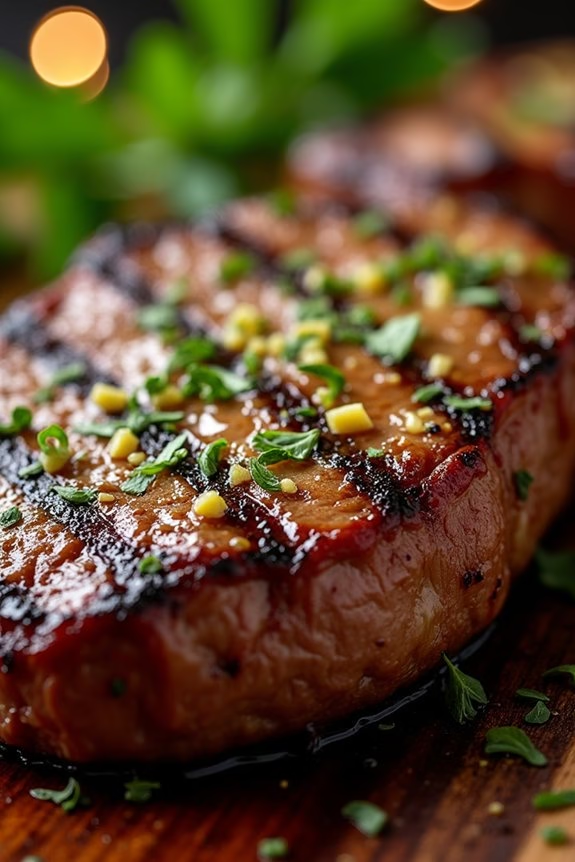
Grilled Ribeye With Garlic Butter is a sumptuous and flavor-filled choice for your Christmas dinner. This classic steak dish is elevated with a rich garlic butter that melts deliciously over the seared ribeye, providing a luxurious, mouth-watering experience. The ribeye, known for its marbling and tenderness, is a perfect cut for grilling, guaranteeing a juicy and flavorful result that will please your guests.
Perfectly grilled ribeye paired with the creamy garlic butter creates an unforgettable dining experience that embodies festive indulgence.
To prepare this dish, choose high-quality ribeye steaks, preferably with good marbling for best flavor. The garlic butter, made with fresh garlic, butter, and herbs, adds a deliciously aromatic touch that complements the richness of the steak. This recipe serves 4-6 people, making it a great option for a small gathering. Follow the instructions below to create a memorable Grilled Ribeye With Garlic Butter for your Christmas dinner.
Ingredients:
- 4 ribeye steaks (about 1 inch thick)
- 1/2 cup unsalted butter, softened
- 4 cloves garlic, minced
- 1 tablespoon fresh parsley, chopped
- 1 teaspoon fresh thyme, chopped
- 1 teaspoon salt
- 1/2 teaspoon ground black pepper
- Olive oil, for brushing
Instructions:
- Prepare the Garlic Butter: In a small bowl, combine the softened butter, minced garlic, chopped parsley, and chopped thyme. Mix well until all ingredients are thoroughly combined. Place the garlic butter on a piece of plastic wrap and shape it into a log. Wrap tightly and refrigerate until firm, about 30 minutes.
- Season the Steaks: Remove the ribeye steaks from the refrigerator about 30 minutes before grilling to bring them to room temperature. Pat them dry with paper towels to remove excess moisture. Season both sides of the steaks with salt and ground black pepper.
- Preheat the Grill: Preheat your grill to high heat. If using a charcoal grill, arrange the coals on one side for direct and indirect grilling. Lightly oil the grill grates to prevent sticking.
- Grill the Ribeye Steaks: Brush each steak lightly with olive oil. Place the steaks on the hot grill over direct heat. Grill for about 4-5 minutes per side for medium-rare, or until the desired doneness is achieved. Use a meat thermometer to check the internal temperature: 130°F for medium-rare, 140°F for medium.
- Rest the Steaks: Once grilled, remove the steaks from the grill and let them rest for 5-10 minutes. This allows the juices to redistribute within the meat, resulting in a juicier steak.
- Serve with Garlic Butter: Slice the chilled garlic butter into rounds. Place a slice of garlic butter on each ribeye steak just before serving, allowing it to melt over the hot steak. Serve immediately with your choice of sides.
Extra Tips: When grilling ribeye, it’s important not to press down on the steaks with a spatula, as this can force the juices out and dry out the meat. Instead, let them cook undisturbed for the recommended time.
Also, consider using a thermometer to guarantee perfect doneness without relying solely on cooking time. If you prefer a more pronounced garlic flavor, increase the garlic in the butter. Finally, if fresh herbs are unavailable, dried herbs can be substituted, but use them sparingly as they’re more potent.
Stuffed Flank Steak Roulade
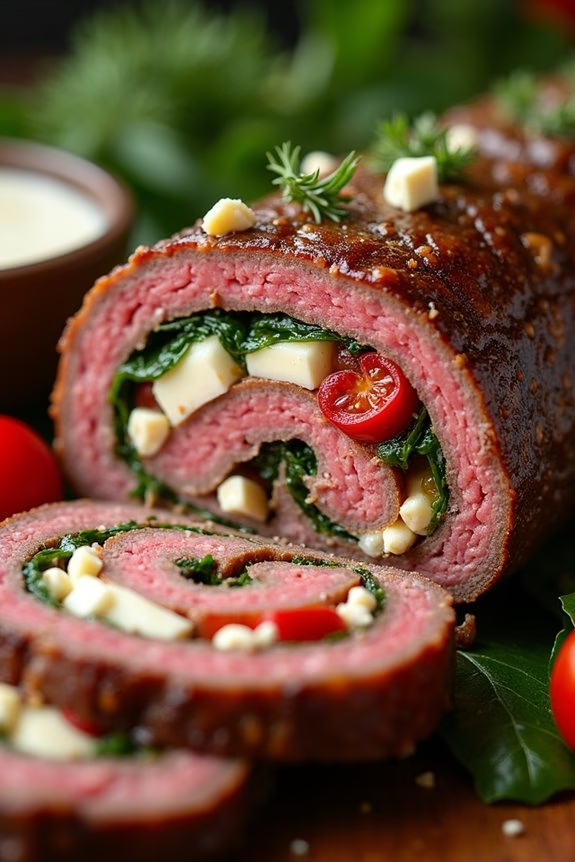
Indulge in a delightful Christmas dinner with this mouthwatering Stuffed Flank Steak Roulade. This dish is a perfect centerpiece for your festive table, combining tender beef with a flavorful stuffing that will tantalize your taste buds.
The roulade isn’t only visually impressive but also packed with rich, savory flavors that embody the warmth and joy of the holiday season. Whether you’re entertaining family or friends, this dish is sure to be a crowd-pleaser.
The flank steak is butterflied and filled with a delicious mixture of spinach, sun-dried tomatoes, garlic, and cheese before being carefully rolled and tied to create a stunning roulade. As the steak roasts in the oven, the flavors meld together, creating a juicy and tender piece of meat that’s as delicious as it’s beautiful.
Serve this Stuffed Flank Steak Roulade with your favorite side dishes for a truly memorable Christmas feast that celebrates the best of seasonal flavors.
Ingredients for 4-6 people:
- 2 pounds of flank steak
- Salt and pepper, to taste
- 2 tablespoons olive oil
- 3 cloves garlic, minced
- 2 cups fresh spinach leaves
- 1/4 cup sun-dried tomatoes, chopped
- 1/2 cup feta cheese, crumbled
- 1/2 cup mozzarella cheese, shredded
- 1 teaspoon dried oregano
- 1 teaspoon dried basil
- Kitchen twine
Cooking Instructions:
- Prepare the Flank Steak: Begin by laying the flank steak on a cutting board. Use a sharp knife to butterfly the steak by slicing it horizontally, being careful not to cut all the way through. Open the steak like a book and cover with plastic wrap. Pound with a meat mallet to even thickness.
- Season the Steak: Remove the plastic wrap and sprinkle both sides of the steak with salt and pepper. Set aside.
- Prepare the Stuffing: Heat olive oil in a skillet over medium heat. Add minced garlic and sauté for about 1 minute until fragrant. Add spinach and cook until wilted. Remove from heat and stir in sun-dried tomatoes, feta cheese, mozzarella cheese, oregano, and basil.
- Stuff the Steak: Spread the prepared stuffing evenly over the butterflied steak, leaving a 1-inch border around the edges. Carefully roll the steak tightly, starting from one of the long sides.
- Secure the Roulade: Use kitchen twine to tie the rolled steak at 1-inch intervals to hold its shape while cooking.
- Sear the Roulade: Preheat your oven to 375°F (190°C). In an ovenproof skillet, heat a tablespoon of olive oil over medium-high heat. Sear the roulade on all sides until browned, about 8-10 minutes total.
- Roast the Roulade: Transfer the skillet to the preheated oven and roast for 20-30 minutes, or until the internal temperature reaches 135°F (57°C) for medium-rare. Adjust the cooking time based on your preferred doneness.
- Rest and Serve: Remove the roulade from the oven and let it rest for 10 minutes. Carefully cut and remove the twine, then slice the roulade into 1-inch thick slices. Serve warm.
Extra Tips:
For the best results, make sure to choose a quality piece of flank steak with an even thickness to guarantee uniform cooking.
If you prefer your steak more well-done, adjust the roasting time accordingly, but be cautious not to overcook and dry out the meat.
Feel free to customize the stuffing with your favorite ingredients, such as mushrooms or roasted red peppers, to add your personal touch to the dish.
Remember to let the roulade rest before slicing to allow the juices to redistribute, resulting in a more flavorful and tender bite.
Korean-Style Beef Bulgogi
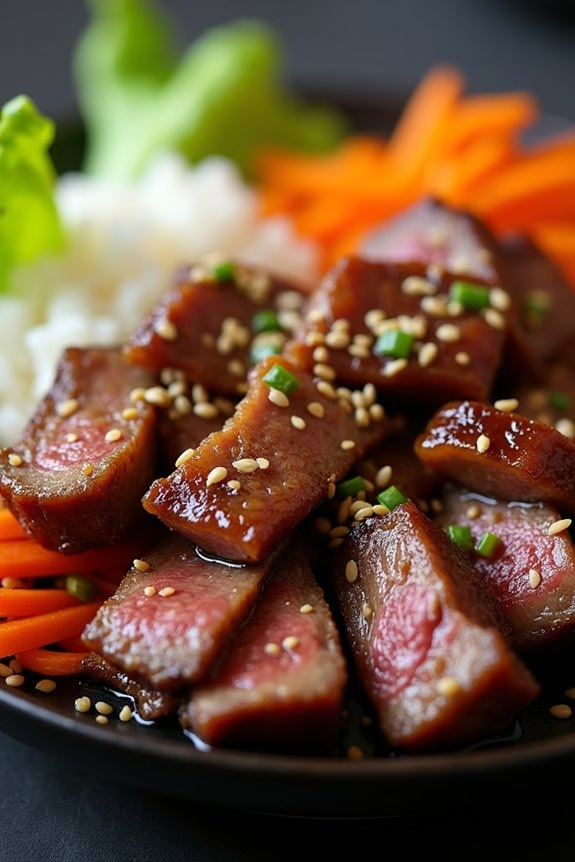
Korean-Style Beef Bulgogi is a delightful dish that brings a taste of Korea straight to your Christmas dinner table. Known for its savory-sweet flavor, this dish combines tender slices of beef with a marinade that infuses the meat with rich, umami flavors. Traditionally grilled, Beef Bulgogi can also be cooked on a stovetop, making it a versatile addition to your festive menu.
The mouthwatering aroma of sizzling beef, combined with garlic, soy sauce, and sesame oil, creates an unforgettable experience for your family and guests. Perfect for serving 4-6 people, this dish is ideal for those looking to add an international flair to their holiday celebrations.
The key to a successful Beef Bulgogi lies in the quality of beef and the marinade’s balance. Thinly sliced ribeye or sirloin works best, as it absorbs the flavors well and cooks quickly. This dish can be served with steamed rice, lettuce wraps, or a side of kimchi, adding a revitalizing crunch to every bite. With its harmonious blend of flavors, Korean-Style Beef Bulgogi is sure to become a new holiday favorite.
Ingredients (Serves 4-6):
- 1 1/2 pounds beef ribeye or sirloin, thinly sliced
- 1/2 cup soy sauce
- 2 tablespoons sugar
- 2 tablespoons sesame oil
- 1 tablespoon mirin (optional)
- 1/4 cup finely chopped green onions
- 2 tablespoons minced garlic
- 1 tablespoon grated ginger
- 1/4 teaspoon black pepper
- 1/2 teaspoon sesame seeds
- 1 medium onion, thinly sliced
- 1 carrot, julienned
- 1 tablespoon vegetable oil
- 1 tablespoon toasted sesame seeds, for garnish
- Lettuce leaves, for serving
- Cooked rice, for serving
Cooking Instructions:
- Prepare the Marinade: In a large bowl, combine soy sauce, sugar, sesame oil, mirin, green onions, minced garlic, grated ginger, and black pepper. Mix well until the sugar is dissolved and the ingredients are fully integrated.
- Marinate the Beef: Add the thinly sliced beef to the marinade, guaranteeing each piece is well coated. Cover the bowl with plastic wrap and refrigerate for at least 1 hour, or overnight for a more intense flavor.
- Prepare the Vegetables: While the beef is marinating, slice the onion thinly and julienne the carrot. Set aside.
- Cook the Beef: Heat the vegetable oil in a large skillet or grill pan over medium-high heat. Add the marinated beef in batches, ensuring not to overcrowd the pan. Cook for about 3-5 minutes on each side until the beef is browned and slightly caramelized.
- Add Vegetables: Once the beef is cooked, add the sliced onion and julienned carrot to the pan. Stir-fry for an additional 2-3 minutes until the vegetables are tender-crisp.
- Garnish and Serve: Sprinkle toasted sesame seeds over the cooked beef and vegetables. Serve the Beef Bulgogi hot, with lettuce leaves and cooked rice on the side for wrapping and enjoying.
Extra Tips:
For the best results, freeze the beef for about 30 minutes before slicing; this makes it easier to achieve thin, even slices. If you prefer a slightly sweeter Bulgogi, increase the sugar to taste.
To enhance the flavors further, consider adding a splash of pear juice or grated Asian pear to the marinade, which adds a subtle sweetness and tenderizes the beef. When cooking, guarantee the pan is hot to achieve a good sear, and avoid overcrowding to prevent steaming.
Enjoy your Korean-Style Beef Bulgogi as a flavorful and festive addition to your Christmas dinner!
Pepper-Crusted Beef Filet Mignon
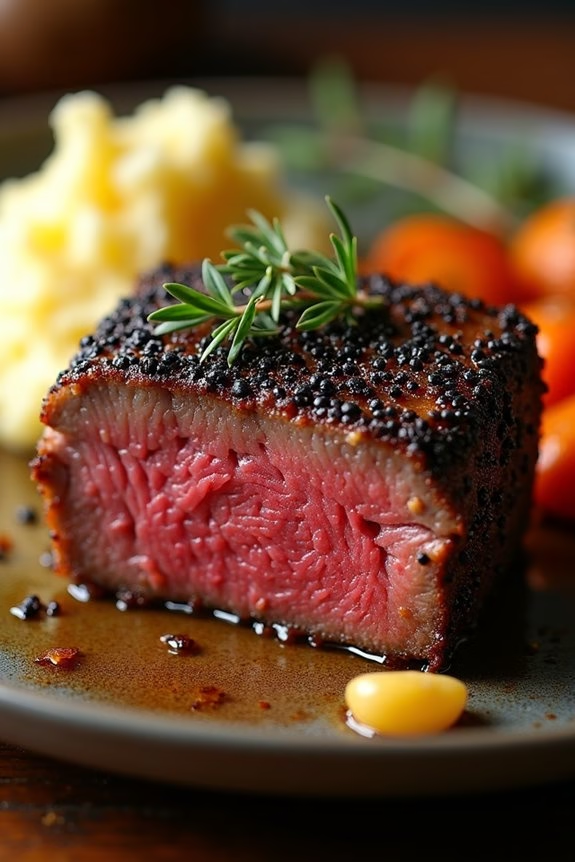
Pepper-Crusted Beef Filet Mignon is a luxurious and flavorful dish that’s perfect for a special occasion like Christmas dinner. The filet mignon, known for its tenderness, is coated with a robust crust of cracked black peppercorns, which adds a delightful contrast to the soft, buttery texture of the beef. This dish is a showstopper on any holiday table, impressing your guests with its exquisite taste and elegant presentation.
Not only is this dish visually appealing, but it also offers a harmonious balance of flavors. The pepper crust enhances the natural taste of the beef, while the searing process locks in the juices, guaranteeing every bite is succulent and flavorful. Pair this dish with your favorite sides, such as creamy mashed potatoes or roasted vegetables, to create a well-rounded and satisfying Christmas meal.
Ingredients for 4-6 servings:
- 4 (6-8 oz) filet mignon steaks
- 2 tablespoons coarsely cracked black peppercorns
- 1 tablespoon sea salt
- 2 tablespoons olive oil
- 2 tablespoons unsalted butter
- 4 cloves garlic, crushed
- 4 sprigs fresh thyme
- 1 cup beef stock
- 1/2 cup red wine (optional)
Cooking Instructions:
- Prepare the Steaks: Take the filet mignon steaks out of the refrigerator at least 30 minutes before cooking. Pat them dry with paper towels to remove any excess moisture, which helps in achieving a good sear.
- Season the Steaks: Generously season the steaks with sea salt and press the cracked black peppercorns onto both sides of each steak to form a crust.
- Preheat the Pan: Heat the olive oil in a large skillet over medium-high heat until it begins to shimmer. This guarantees the pan is hot enough to sear the steaks properly.
- Sear the Steaks: Add the steaks to the pan and sear them for 3-4 minutes on each side, depending on your desired level of doneness. The exterior should be nicely browned and crusty.
- Add Butter and Aromatics: Reduce the heat to medium and add the butter, crushed garlic, and thyme sprigs to the pan. Baste the steaks with the melted butter using a spoon for about 1 minute.
- Finish Cooking: Transfer the skillet to a preheated oven at 400°F (200°C) to finish cooking the steaks to your desired doneness, approximately 5-7 minutes for medium-rare.
- Rest the Steaks: Remove the steaks from the oven and let them rest on a cutting board for at least 5 minutes. This allows the juices to redistribute, guaranteeing tender and juicy meat.
- Make the Pan Sauce (optional): Place the skillet back on the stove over medium heat. Add the beef stock and red wine to deglaze the pan, scraping up any bits from the bottom. Let it simmer and reduce by half, then strain and serve alongside the steaks.
Extra Tips:
When preparing Pepper-Crusted Beef Filet Mignon, guarantee that the steaks are of uniform thickness to promote even cooking. Use a meat thermometer to check the internal temperature, aiming for 130°F (54°C) for medium-rare.
Letting the steaks rest after cooking is vital for maintaining their juiciness. Additionally, if you prefer a milder pepper flavor, consider mixing the cracked pepper with finely chopped herbs before crusting the steaks. Adjust the seasoning to your taste and enjoy the rich flavors of this elegant dish.
Guinness-Braised Beef Brisket
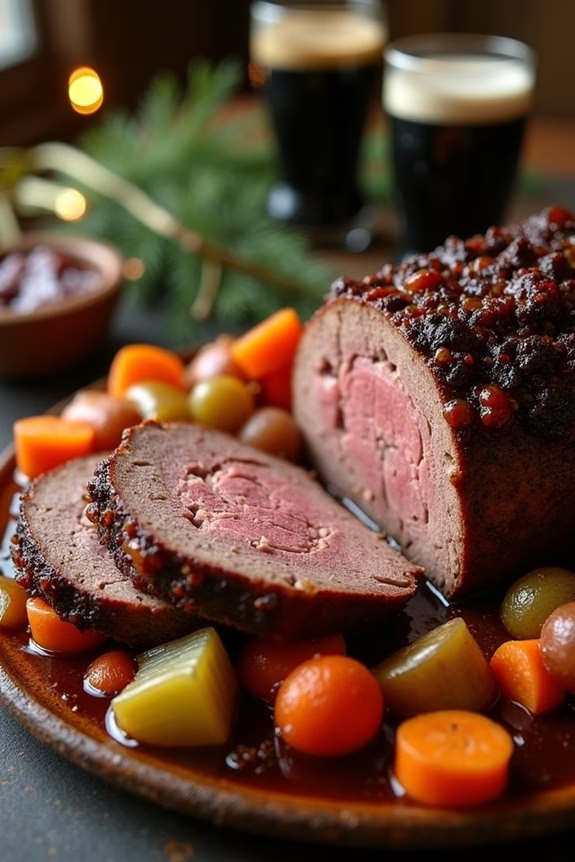
This recipe is ideal for serving 4-6 people, making it an excellent option for a small gathering or family celebration. The combination of Guinness and aromatic herbs will fill your home with a delightful aroma, setting the perfect mood for a cozy and memorable holiday dinner.
Ingredients (serving size: 4-6 people):
- 3-4 lbs beef brisket
- 1 bottle (11.2 oz) Guinness stout
- 2 cups beef broth
- 2 tablespoons olive oil
- 2 large onions, sliced
- 4 cloves garlic, minced
- 3 carrots, peeled and sliced
- 3 stalks celery, sliced
- 2 tablespoons tomato paste
- 2 tablespoons Worcestershire sauce
- 2 bay leaves
- 1 teaspoon dried thyme
- Salt and pepper, to taste
Instructions:
- Prepare the Brisket: Pat the brisket dry with paper towels and season generously with salt and pepper on both sides.
- Sear the Brisket: Heat olive oil in a large Dutch oven or heavy pot over medium-high heat. Add the brisket and sear on both sides until browned, about 4-5 minutes per side. Remove the brisket and set aside.
- Cook the Vegetables: In the same pot, add the onions, carrots, and celery. Cook for about 5-7 minutes until the vegetables start to soften. Add the garlic and cook for an additional 1 minute until fragrant.
- Deglaze the Pot: Stir in the tomato paste and cook for 1-2 minutes. Pour in the Guinness stout, scraping up any browned bits from the bottom of the pot. Let it simmer for 3-4 minutes to reduce slightly.
- Combine All Ingredients: Return the brisket to the pot. Add the beef broth, Worcestershire sauce, bay leaves, and thyme. Bring the mixture to a simmer.
- Braise the Brisket: Cover the pot with a lid and transfer it to a preheated oven at 300°F (150°C). Braise for 3-4 hours, or until the brisket is fork-tender. Check occasionally to verify the liquid level is maintained, adding more broth if necessary.
- Rest and Serve: Remove the brisket from the oven and let it rest for 15 minutes before slicing. Serve with the braising liquid and vegetables spooned over the top.
Extra Tips: For an even deeper flavor, marinate the brisket in the Guinness and seasoning mix overnight in the refrigerator before cooking.
If you prefer a thicker sauce, remove the brisket once cooked and simmer the braising liquid on the stovetop until it reduces to your desired consistency. This dish pairs wonderfully with mashed potatoes or crusty bread to soak up the rich sauce.
Beef Stroganoff With Creamy Sauce
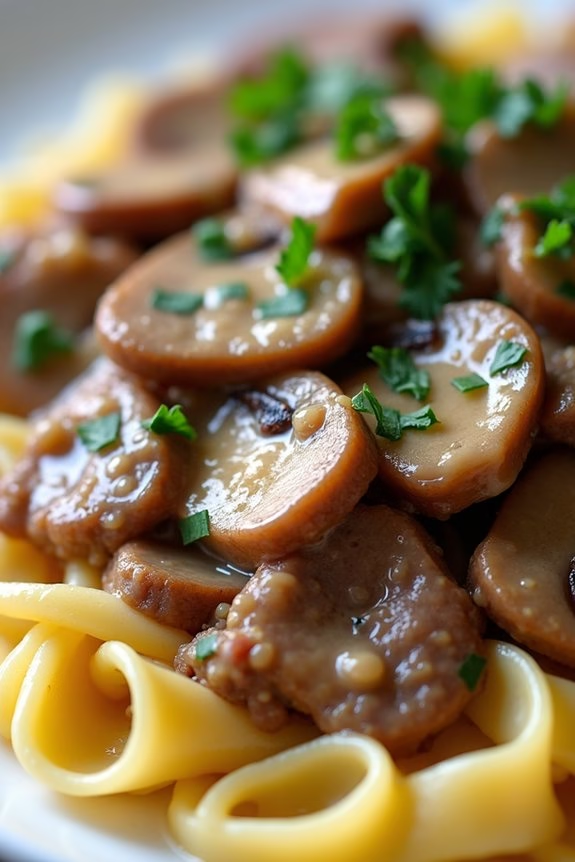
Beef Stroganoff is a classic comfort dish that combines tender strips of beef with a rich and creamy sauce, perfect for a festive Christmas dinner. Originating from Russia, this dish has become a favorite around the world due to its delightful blend of flavors and textures. The creamy sauce, made with sour cream and beef broth, envelops the savory beef, while the addition of mushrooms and onions adds depth and earthiness to the dish.
Traditionally served over egg noodles or rice, Beef Stroganoff is both hearty and satisfying, making it an ideal choice for a special holiday meal.
Preparing Beef Stroganoff with a creamy sauce involves selecting quality beef, such as sirloin or tenderloin, to guarantee tenderness and flavor. The key to a successful Stroganoff lies in the balance of its ingredients and the technique of cooking the beef to perfection. By following the steps below, you can create a warm and inviting dish that will impress your guests and become a cherished part of your Christmas dinner tradition. The recipe below serves 4-6 people, making it perfect for a family gathering or intimate holiday celebration.
Ingredients:
- 1.5 pounds beef sirloin or tenderloin, thinly sliced
- 2 tablespoons olive oil
- 1 large onion, finely chopped
- 2 cups mushrooms, sliced
- 3 cloves garlic, minced
- 1 cup beef broth
- 1 cup sour cream
- 2 tablespoons Dijon mustard
- 2 tablespoons flour
- 1 tablespoon Worcestershire sauce
- Salt and pepper to taste
- Fresh parsley, chopped (for garnish)
- Cooked egg noodles or rice for serving
Cooking Instructions:
- Prepare the Ingredients: Begin by slicing the beef into thin strips, approximately 1/2 inch thick. Season the beef with salt and pepper to taste. Chop the onion finely, slice the mushrooms, and mince the garlic.
- Sear the Beef: Heat the olive oil in a large skillet over medium-high heat. Add the beef strips to the skillet in batches, making sure not to overcrowd the pan. Sear the beef until browned on all sides, about 3-4 minutes per batch. Remove the beef from the skillet and set aside.
- Cook the Vegetables: In the same skillet, add the chopped onion and sliced mushrooms. Sauté until the onion becomes translucent and the mushrooms are browned, about 5-7 minutes. Stir in the minced garlic and cook for an additional 1 minute until fragrant.
- Make the Sauce: Sprinkle the flour over the vegetables and stir until well combined. Gradually pour in the beef broth while stirring constantly to prevent lumps. Add the Dijon mustard and Worcestershire sauce, and bring the mixture to a simmer.
- Combine and Simmer: Return the seared beef to the skillet, stirring to coat the beef with the sauce. Reduce the heat to low and let the mixture simmer for about 10-15 minutes, allowing the flavors to meld together.
- Add the Sour Cream: Remove the skillet from the heat and stir in the sour cream until the sauce is smooth and creamy. Taste and adjust seasoning with additional salt and pepper if needed.
- Serve: Serve the Beef Stroganoff over cooked egg noodles or rice. Garnish with freshly chopped parsley for a pop of color and added flavor.
Extra Tips:
When making Beef Stroganoff, it’s essential to avoid overcooking the beef to maintain its tenderness. Searing the beef quickly at a high temperature helps to lock in its juices.
For an added depth of flavor, consider using a combination of cremini and button mushrooms. Additionally, allowing the dish to rest for a few minutes after adding the sour cream will enhance the creaminess of the sauce.
If you prefer a thicker sauce, you can increase the amount of flour used in the recipe, or if you want a lighter version, substitute part of the sour cream with Greek yogurt.
Argentine Chimichurri Skirt Steak
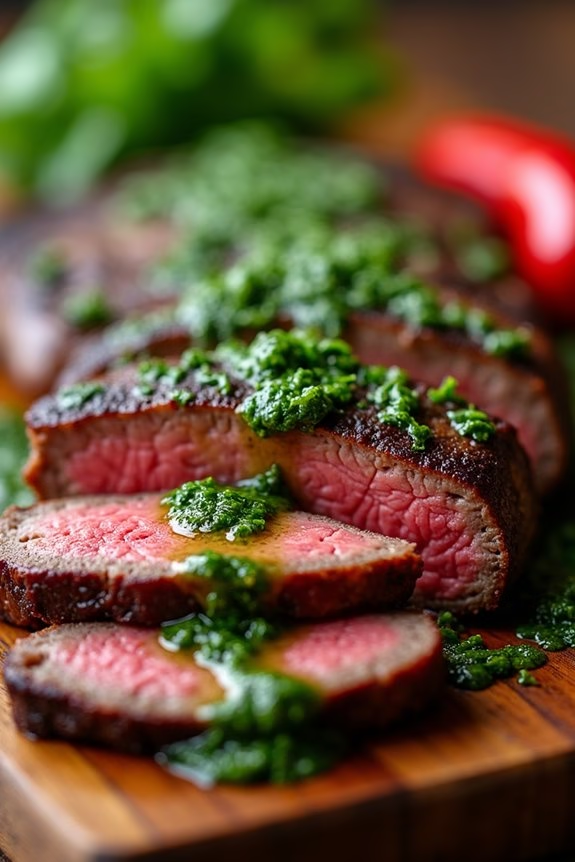
Argentine Chimichurri Skirt Steak is a delicious and flavorful dish that will add a touch of South American flair to your Christmas dinner. This dish combines the robust flavors of grilled skirt steak with the fresh, herby taste of chimichurri sauce, a classic Argentine condiment made with parsley, garlic, vinegar, and chili. The combination of the smoky, savory steak with the bright, tangy sauce makes for a truly unforgettable meal.
Perfect for those looking to add some international cuisine to their holiday table, this dish is bound to impress your guests with its vibrant flavors and stunning presentation.
The key to a perfect Argentine Chimichurri Skirt Steak is in the preparation of both the steak and the chimichurri sauce. The skirt steak, known for its rich flavor, is best when marinated to enhance its natural juices and then grilled to perfection.
Meanwhile, the chimichurri sauce, which can be made ahead of time, needs to be fresh and vibrant, allowing the herbs and spices to infuse together. This dish serves 4-6 people, making it ideal for a festive gathering. With a few simple steps, you can create a meal that celebrates the best of Argentine cuisine.
Ingredients for 4-6 people:
- 1 1/2 pounds skirt steak
- 1/2 cup red wine vinegar
- 1 teaspoon kosher salt
- 3-4 garlic cloves, minced
- 1 shallot, finely chopped
- 1 red chili, finely chopped
- 1/2 cup fresh parsley, finely chopped
- 1/4 cup fresh oregano, finely chopped
- 3/4 cup extra-virgin olive oil
- Freshly ground black pepper, to taste
Cooking Instructions:
- Prepare the Chimichurri Sauce: In a medium bowl, combine the red wine vinegar and kosher salt. Stir until the salt dissolves. Add the minced garlic, chopped shallot, and chili, mixing well. Let this mixture sit for about 10 minutes to meld the flavors.
- Add Herbs and Oil: Stir in the chopped parsley and oregano. Gradually whisk in the olive oil until well combined. Season with freshly ground black pepper to taste. Cover the bowl with plastic wrap and set aside to allow the flavors to deepen.
- Marinate the Steak: Place the skirt steak in a shallow dish. Spoon a few tablespoons of the chimichurri sauce over the steak, turning to coat evenly. Cover the steak with plastic wrap and marinate in the refrigerator for at least 1 hour, preferably longer for maximum flavor.
- Preheat the Grill: Prepare your grill for high heat. If using a gas grill, preheat to about 500°F. For charcoal, confirm the coals are white hot before cooking.
- Grill the Steak: Remove the steak from the refrigerator 30 minutes before grilling to bring it to room temperature. Place the steak on the hot grill, cooking for about 3-4 minutes per side for medium-rare, or until desired doneness. Use tongs to flip the steak, avoiding piercing the meat to retain juices.
- Rest the Steak: Once cooked, transfer the steak to a cutting board and let it rest for 5-10 minutes. This allows the juices to redistribute throughout the meat.
- Serve: Slice the steak against the grain into thin strips. Serve with the remaining chimichurri sauce on the side or drizzled over the top.
Extra Tips:
For the best results, use fresh herbs for the chimichurri sauce, as dried herbs won’t have the same vibrant flavor. If possible, prepare the chimichurri sauce a day ahead to allow the flavors to fully develop.
When grilling the steak, be careful not to overcook it; skirt steak is best enjoyed at medium-rare to medium. Finally, always slice the steak against the grain for maximum tenderness. Enjoy this flavorful dish alongside traditional Christmas sides for a unique holiday feast.
Spiced Beef and Chestnut Stew
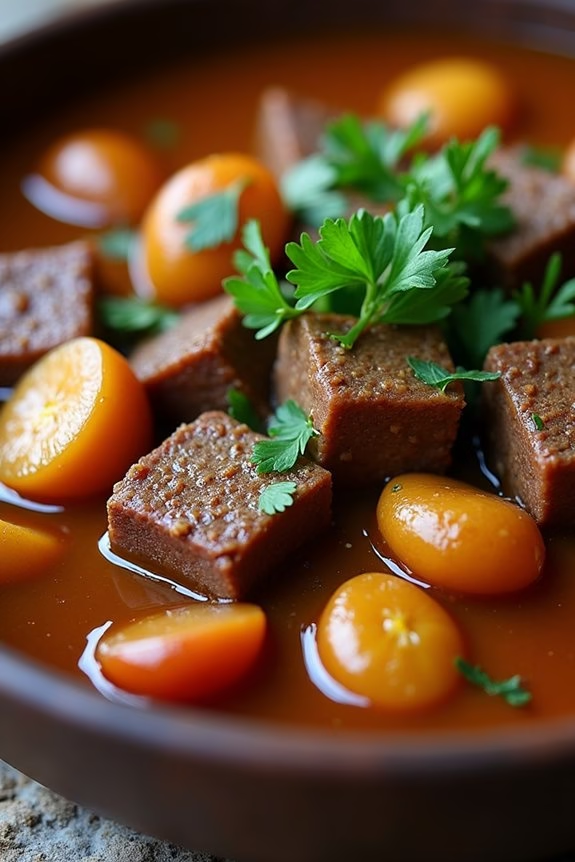
Spiced Beef and Chestnut Stew is a warm and hearty dish, perfect for gathering around the Christmas table. This stew brings together tender pieces of beef, the earthy sweetness of chestnuts, and a blend of aromatic spices that evoke the festive spirit. The slow-cooked beef becomes incredibly tender, while the chestnuts add a unique texture and flavor, making this dish a standout on your holiday menu.
It’s a comforting meal that not only satisfies hunger but also fills your home with its enticing aroma. Ideal for a serving size of 4-6 people, this Spiced Beef and Chestnut Stew is both a crowd-pleaser and a conversation starter. The combination of spices, including warming cinnamon and nutmeg, alongside fresh herbs, elevates the stew, making it not just a meal but an experience.
Serve it with crusty bread or over a bed of creamy mashed potatoes to soak up the rich and flavorful sauce. This is a dish that invites everyone to slow down, savor each bite, and enjoy the moment.
Ingredients:
- 2 lbs beef chuck, cut into 1-inch cubes
- 2 tablespoons olive oil
- 1 large onion, finely chopped
- 3 cloves garlic, minced
- 1 tablespoon tomato paste
- 1 teaspoon ground cinnamon
- 1/2 teaspoon ground nutmeg
- 2 cups beef stock
- 1 cup red wine
- 2 tablespoons Worcestershire sauce
- 1 bay leaf
- 8 oz cooked and peeled chestnuts
- Salt and pepper to taste
- Fresh parsley, chopped (for garnish)
Cooking Instructions:
- Prepare the Beef: Pat the beef cubes dry with paper towels and season with salt and pepper. This will guarantee the beef browns properly.
- Brown the Beef: Heat olive oil in a large Dutch oven or heavy pot over medium-high heat. Add the beef cubes in batches, being careful not to overcrowd the pan, and brown them on all sides. Remove the beef and set aside.
- Sauté the Aromatics: In the same pot, add the chopped onion and sauté until translucent, about 5 minutes. Add the minced garlic and cook for another minute until fragrant.
- Tomato Paste and Spices: Stir in the tomato paste, ground cinnamon, and nutmeg, cooking for an additional 1-2 minutes to allow the spices to release their aromas.
- Deglaze and Simmer: Pour in the red wine, scraping the bottom of the pot to release any browned bits. Once the wine has reduced slightly, add the beef stock, Worcestershire sauce, and bay leaf. Return the beef to the pot, bring to a boil, then reduce the heat to low.
- Cook the Stew: Cover and simmer for 1.5 to 2 hours, or until the beef is tender. Check occasionally to confirm the liquid level is sufficient, adding more stock if needed.
- Add the Chestnuts: About 20 minutes before the stew is done, add the cooked chestnuts to the pot. This allows them to warm through and absorb some of the flavors of the stew.
- Adjust Seasoning and Serve: Taste the stew and adjust seasoning with salt and pepper as necessary. Remove the bay leaf before serving. Garnish with fresh parsley and serve hot.
Extra Tips: For the best results, use a good quality beef chuck, as it becomes wonderfully tender when slow-cooked. If fresh chestnuts are unavailable, vacuum-packed or canned chestnuts can be used as a substitute.
When it comes to wine, choose a full-bodied red that you’d enjoy drinking, as it will enhance the flavor of the stew. Finally, this dish can be made a day ahead and reheated, as the flavors develop and improve over time, making it even more delicious.
Italian-Style Osso Buco With Gremolata

Italian-Style Osso Buco With Gremolata is a classic dish that combines the rich flavors of braised veal shanks with a bright, zesty topping of gremolata. This dish is perfect for a festive Christmas dinner, offering a hearty yet elegant option that will impress your guests. The slow-cooked meat becomes tender and flavorful, while the gremolata adds a revitalizing citrus note that balances the richness of the stew.
Originating from Milan, Osso Buco is traditionally served with a side of risotto or polenta to soak up the delicious sauce. This recipe is designed to serve 4-6 people, making it suitable for a cozy family gathering or a small dinner party. The steps are straightforward, ensuring that even novice cooks can achieve a stunning result with this Italian favorite.
Ingredients (Serves 4-6):
- 4 to 6 veal shanks, each about 1 1/2 inches thick
- Salt and freshly ground black pepper
- 1/2 cup all-purpose flour, for dusting
- 1/4 cup olive oil
- 2 tablespoons unsalted butter
- 1 onion, chopped
- 2 carrots, diced
- 2 celery stalks, diced
- 3 cloves garlic, minced
- 1 cup dry white wine
- 1 cup beef or veal stock
- 1 can (14 ounces) crushed tomatoes
- 1 bay leaf
- 1 teaspoon dried thyme
- Zest of 1 lemon
- 2 tablespoons fresh parsley, chopped
- 1 clove garlic, minced (for gremolata)
Cooking Instructions:
- Prepare the Veal Shanks: Season the veal shanks generously with salt and pepper. Dust each shank lightly with flour, shaking off any excess. This will help to create a nice crust when browning.
- Brown the Shanks: In a large, heavy-bottomed pot or Dutch oven, heat the olive oil and butter over medium heat. Add the veal shanks in batches, and brown them on all sides, about 3-4 minutes per side. Remove the shanks and set them aside.
- Sauté the Vegetables: In the same pot, add the chopped onion, carrots, and celery. Sauté for about 5-7 minutes until they begin to soften. Add the minced garlic and cook for an additional minute until fragrant.
- Deglaze the Pot: Pour in the white wine, scraping up any browned bits from the bottom of the pot. Allow the wine to reduce by half, about 3-5 minutes.
- Braise the Shanks: Return the veal shanks to the pot. Add the beef stock, crushed tomatoes, bay leaf, and thyme. Bring the mixture to a simmer, then cover and reduce the heat to low. Let the shanks braise for about 1.5 to 2 hours, or until the meat is tender and easily pulls away from the bone.
- Make the Gremolata: While the shanks are cooking, prepare the gremolata by combining the lemon zest, chopped parsley, and minced garlic in a small bowl. Mix well to combine.
- Serve: Once the veal shanks are tender, remove the bay leaf and transfer the shanks to a serving platter. Spoon some of the sauce over the top, and sprinkle with the gremolata. Serve the Osso Buco hot, accompanied by risotto or polenta.
Extra Tips: For the best flavor, try making this dish a day ahead. Allowing the meat to sit in the sauce overnight enhances the flavors, and simply reheat gently before serving. If veal shanks aren’t available, you can substitute with beef shanks, although the cooking time may need to be adjusted slightly. Be sure to taste the sauce and adjust the seasoning before serving, as braising can sometimes require a touch more salt or pepper.

